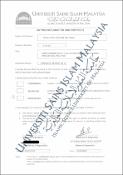Options
Forecasting Zakat Collection In Malaysia Using Time Series Analysis
Date Issued
2022-03
Author(s)
Mohd Fadlihisyam bin Ishak
Abstract
Holt-Winters and Seasonal Auto-Regressive Integrated Moving Average (SARIMA) models are used to predict monthly zakat collection in Lembaga Zakat Selangor (LZS), Pusat Zakat Negeri Sembilan (PZNS), and Pusat Pungutan Zakat (PPZ) using zakat collection data from January 2010 to December 2019. Nonseasonal models such as the Auto-Regressive Integrated Moving Average (ARIMA) and the Single Smoothing Exponential are used to predict yearly zakat collections in Majlis Agama Islam dan Adat Melayu Perak (MAIPk) using zakat collection data from year 1991 to 2019. In this research, we compare the forecasted values of both models and select the best model based on the least Mean Square Error (MSE), Root Mean Square Error (RMSE), Mean Absolute Error (MAE), and Mean Absolute Percentage Error (MAPE). The objective of this study is to find the best model for forecasting zakat collection for a zakat institution. According to the results obtained using MSE, RMSE, MAE, and MAPE, the ARIMA(1,1,1) (1,1,1)12 and ARIMA(0,1,1) (0,1,1)12 models were found to be a better model for PZNS and PPZ, respectively. The ARIMA(1,1,1) (1,1,1)12 was found to be a better model for LZS based on MSE error. The ARIMA model was found to be the best fit for MAIPk and could be used to forecast future values from 2020 to 2031. The study shows that these models can accurately predict future zakat collection to prepare the appropriate strategies and plan for zakat distribution without leaving any surplus. These models can also be used to create a strategy to handle zakat funds based on the amount of asnaf registered.
File(s)

Loading...
Name
3181377 Declaration.pdf
Size
237.35 KB
Format
Adobe PDF
Checksum
(MD5):62aeeed8e6a1c0500a72dbe3ee9d5118
Loading...
Name
3181377 Introduction.pdf
Size
1.41 MB
Format
Adobe PDF
Checksum
(MD5):ba7970e78cb5efadfeaeeb6d7bfdfa20